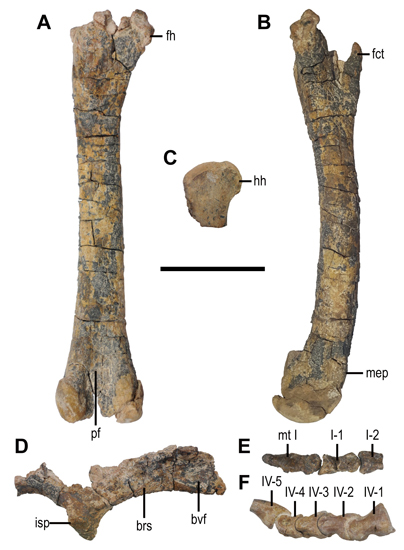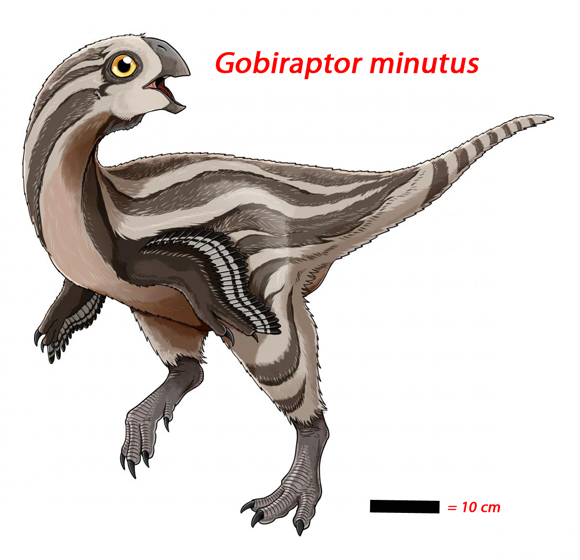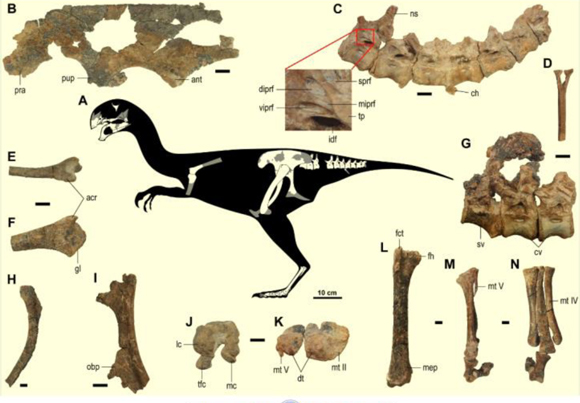Gobiraptor minutus – The Diversity of the Oviraptoridae in the Late Cretaceous
A new species of oviraptorid dinosaur (Oviraptoridae family), has been described by an international team of scientists. The little dinosaur was probably feathered and it possessed thickened jaws, an adaptation to feeding on hard food items such as seeds, nuts or the shells of bivalves, molluscs and crabs. Animals that have a diet of hard items are referred to as durophagous.
The fossilised remains of a single, very young individual were found in the Altan Uul area of Ömnögovi Province, Mongolia, in strata from the famous Upper Cretaceous Nemegt Formation. The new species has been named Gobiraptor minutus and it helps to demonstrate that this part of Asia in the Late Cretaceous was home to diverse variety of oviraptorids, many of which, probably occupied specialist niches within the ecosystem in a bid to minimise competition for resources.
A Life Reconstruction of Gobiraptor minutus
Picture credit: Do Yoon Kim with additional annotation by Everything Dinosaur
Gobiraptor minutus – Rare for the Altan Uul Area of Southern Mongolia
Oviraptorid fossil specimens are relatively rare in the Altan Uul area of the Gobi Desert, however, within the Upper Cretaceous deposits exposed within the Gobi Desert, some ten oviraptorid taxa have so far been named and described. Gobiraptor increases the diversity of oviraptorids known from the Nemegt Formation and demonstrates that these types of theropod dinosaurs were exceptionally abundant in the mesic environment* of that part of the world during the Late Cretaceous.
A mesic environment* – is a term used in ecology to describe an environment with a moderate amount of water. Much of this part of Asia during the Late Cretaceous may be associated with a dry, arid environment, for example numerous types of other theropod fossils come from strata that represent almost desert-like conditions. These fossils are found in the older Barun Goyot Formation which was laid down under more arid conditions. The rocks in which the fossils of Gobiraptor were found consist mainly of river channel deposits, indicating that the palaeoenvironment changed and the environment became considerably wetter.
Thus, the finding of a new member of the Oviraptoridae family in the Nemegt Formation, which consists mostly of river and lake deposits, confirms that these dinosaurs were extremely well adapted to wet habitats.
Fragmentary Fossils and Skeletal Reconstruction of Gobiraptor minutus
Picture credit: PLOS One
Robust and Thickened Jaws Hint at a Dietary Specialism
Gobiraptor minutus, can be differentiated from other members of the Oviraptorosauria clade in having unusually robust and thickened jaws. This unique mandibular morphology suggests that Gobiraptor was adapted to feeding on hard food items, it used its strong jaws to crush, indicating potential niche partitioning in the palaeoenvironment to reduce competition amongst small theropods and within the local population of oviraptorids. Osteological analysis of the femur suggests that the fossil material represents a very young individual.
The phylogenetic analysis carried out by the researchers defines Gobiraptor as a derived oviraptorid closely related to three taxa from the Ganzhou region of southern China, but, ironically, the analysis suggests that it was rather distantly related to other Nemegt oviraptorids which, as the results of recent studies, are also not closely related to each other.
The authors propose that different dietary strategies may explain the wide taxonomic diversity and evolutionary success of this group of dinosaurs in this part of Asia.
Post-cranial Elements of G. minutus

Picture credit: PLOS One
The genus name honours the Gobi Desert, whilst the specific epithet is from the Latin for small, a reflection on the small size of the holotype.
The scientific paper: “A New Baby Oviraptorid Dinosaur (Dinosauria, Theropoda) from the Upper Cretaceous Nemegt Formation of Mongolia” by Sungjin Lee, Yuong-Nam Lee , Anusuya Chinsamy, Junchang Lü, Rinchen Barsbold and Khishigjav Tsogtbaatar published in PLOS One.
Visit the award-winning Everything Dinosaur website: Everything Dinosaur.








Leave A Comment